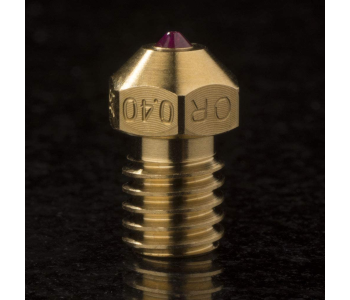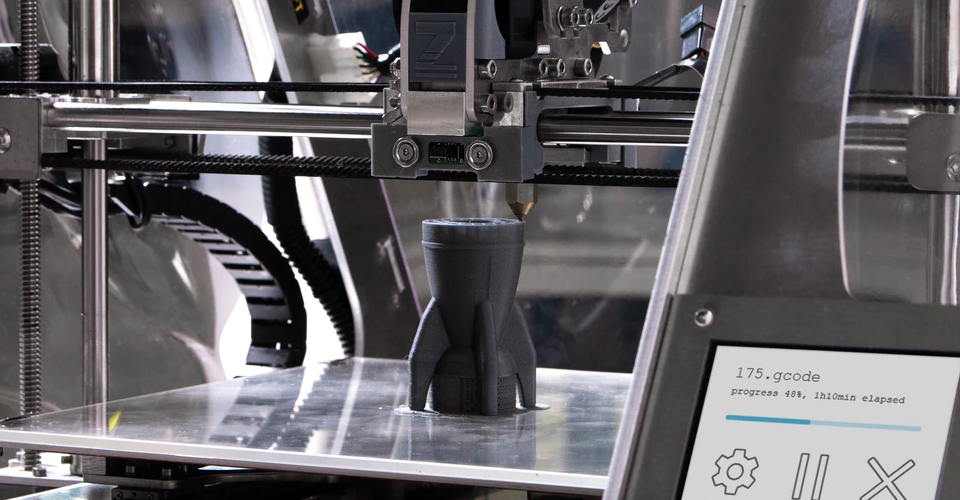A Guide to Different 3D Printer Nozzle Materials and Types
We have already discussed how the nozzles of 3D printers come in different sizes, and how each going with an alternative to the stock nozzle can have both benefits and drawbacks. However, there’s another variable we have not considered yet – the material of the nozzle.
While the material of the nozzle does not affect the appearance or quality of the finished print to the same degree as its opening size, certain nozzle types are more compatible with specific filaments. Sounds confusing? Check out our guide below to help clear it up.
Brass

A brass 0.4-millimeter nozzle is the typical stock nozzle that comes by default with almost all 3D printers. It’s a default option mostly because of how inexpensive brass is, but also because it’s reliable enough for most filament materials.
Cheap
The main reason for why the brass nozzle is the default component when you buy a 3D printer is that it’s the most inexpensive option. Not only is brass a relatively cheap material, but its also a soft metal that is easy to machine and manufacture. If you plan on having an array of different nozzles or simply like having spare ones on the side, then getting a couple of brass nozzles is an option that will not set you back by much.
Has good thermal conductivity
Brass isn’t a good material just because it’s cheap – it’s also a very good conductor. This means that it transfers heat from the heating element to the very tip of the nozzle much more efficiently, resulting in more uniform heat distribution. This massively helps if you’re running into issues related to warping, bed adhesion, or layer-to-layer adhesion. The boost in efficiency also means that you can print at higher speeds without compromising on product quality.
Prone to abrasion
As we’ve said, brass is a soft metal. This is ideal when it comes to machining the nozzle during manufacturing but makes it unsuitable when working with abrasive filaments. Composite filaments, or filaments with embedded solid particles, are particularly problematic if you have a brass nozzle installed on your 3D printer.
Repeated use of a brass nozzle with a composite filament will inevitably result in the brass material getting worn down, thus widening the opening of the nozzle. This will then lead to inconsistent product quality, especially if you’re printing designs with fine details. In the long run, relying exclusively on brass nozzles may mean that you end up replacing nozzles more often than if you had gone for a more abrasion-resistant alternative.
Sticking with the standard brass nozzle isn’t going to be a problem if you’re working with the usual filament materials like PLA, ABS, Nylon, or PETG. Its high conductivity actually makes it a versatile tool, especially if you’re aiming for more efficient use of your 3D printer. In most cases, there would be no need for a 3D printing hobbyist to make an upgrade from a brass nozzle.
However, a brass nozzle simply won’t do if you want to use composite filaments. The visual appeal of these composite filaments is undeniable, especially if you’re tired of the same old “plastic” look of 3D prints.
Stainless steel
A stainless steel nozzle is the most sensible upgrade to a brass one. It looks great, isn’t incredibly expensive, and retains the same material versatility as brass. It performs better for abrasive filaments but slightly loses out on the heat conductivity of good old-fashioned brass.
Better abrasion resistance
Compared to brass, stainless steel is far more suited to printing with an abrasive filament. However, stainless steel is also not the most abrasion-resistant material available of nozzles. This middle-ground option is optimal if you print with abrasive filaments every now and then. If you use abrasive filaments heavily, you may still find yourself having to replace stainless steel nozzles quite frequently.
Certified as food-safe
A stainless steel nozzle is essential if you’re 3D printing objects that are meant for food contact or for contact with human skin. This is because stainless steel contains no lead, and thus will not impart this toxic metal to the molten filament as it gets extruded. Stainless steel is the only nozzle material that has been approved by the FDA as food-safe.
Smooth interior finish
Stainless steel nozzles are manufactured to have a deliberately smooth interior finish. This helps in snag-free extrusion of the filament, making it less likely for the nozzle to clog. While clogging shouldn’t be much of a problem as long as you clean the nozzle regularly and use the proper printer settings, it’s still nice to have a bit of leeway by using a stainless steel nozzle.
Poor thermal conductivity
When swapping brass for a stainless steel nozzle, the most major compromise you’ll have to accept is the drop in thermal conductivity. Stainless steel heats up quite poorly compared to brass, making the printing process a bit less efficient. This can be problematic if the filament needs to be retracted repeatedly throughout a project, as there’s an increased tendency of the filament to cool down inside the nozzle and clog up.
Upgrading to a stainless steel nozzle is practical if you like to use composite filaments every now and then but typically still stick to standard filaments for your regular projects. If you’re printing objects for contact with food, then upgrading to stainless steel becomes a necessity rather than an option. While the abrasion resistance of stainless steel is clearly superior to brass, it’s still not the best option for heavy use of abrasive filaments.
Hardened steel

If you use abrasive filaments a lot, then investing in a hardened steel nozzle will be a wise decision. Hardened steel can be up to ten times more wear-resistant than other nozzle materials. These nozzles can last for an incredibly long time given proper maintenance.
Highly wear-resistant
In terms of wear resistance and overall toughness, no other nozzle material can compete with hardened steel. If you’re planning to print multiple projects with composite filament, then it would be best to swap out your stock nozzle with something made of hardened steel. This will ensure the consistent quality of your finished prints and will not have you replacing a worn-out nozzle after just several hours.
Rough interior finish
Unlike stainless steel, the manufacturing process of hardened steel makes the nozzle prone to having a rough interior finish. This is counter-productive to the goal of allowing the filament to extrude through the nozzle snag-free. Coupled with its poor thermal conductivity, this characteristic makes hardened steel nozzles more likely to clog.
Not food-safe
Hardened steel is NOT appropriate for 3D printing objects made for food contact. The reason is simple – hardened steel contains lead, and there is no guarantee that this metal will not seep into the molten plastic filament as it gets extruded through the nozzle.
Poor thermal conductivity
In terms of thermal conductivity, hardened steel sits somewhere mid-way between brass and stainless steel. The downgrade from brass is still very palpable, although this shouldn’t be much of an issue if you’re just printing with PLA-based composite filament.
In terms of longevity, hardened steel is the premium nozzle material option. This becomes much more important if you’re printing with a composite filament that contains highly abrasive solids, such as metal or carbon fiber.
The size of the opening of the nozzle also plays a huge role in avoiding excessive wear and clogging of the solid material. For the composite filament, we recommend using a hardened steel nozzle with an opening that is not smaller than 0.5 millimeters.
Ruby-tipped

A ruby-tipped nozzle is a specialty nozzle that was designed to combine the superior thermal conductivity of brass with one of the hardest materials in the world. There is only one such product that exists right now – the Olsson Ruby nozzle.
The Olsson Ruby nozzle has a body made of standard brass but has a tip made of ruby. One of the toughest naturally occurring materials in the world, ruby is third only diamond and cubic boron nitride. Even compared to hardened steel, the wear resistance of the ruby tip is magnitudes higher. This can be particularly useful if you’re printing with very abrasive filaments like carbon fiber.
There is also a high-temperature variant of the Olsson Ruby nozzle that comes with a hardened metal body instead of brass. The internal surface of the nozzle has been coated with chromium nitride to address the discrepancy of hardened steel when it comes to having a smooth finish. The inclusion of copper in the metal also enhances the metal’s conductivity.
Retains good thermal conductivity
The composite construction of an Olsson Ruby nozzle allows it to achieve good resistance to abrasion without compromising on thermal conductivity. This successfully bridges the major drawback of brass when it comes to longevity. The ability of brass to heat up quickly ensures more uniform heating of the filament inside the nozzle, resulting in better print quality parameters such as finish and layer-to-layer adhesion.
Unequaled wear resistance
The use of ruby as material for the tip of the nozzle is an entirely new level of innovation displayed by the designers of the Olsson Ruby. According to the test that they have conducted, the ruby tip shows no sign of wear even after printing 8 kilograms of carbon fiber filament. In comparison, even a hardened steel nozzle was visibly worn down after receiving the same treatment.
Very expensive
An Olsson Ruby nozzle can be more than ten times more expensive than a brass nozzle and about five times more expensive than a hardened steel nozzle. If you were wondering why not more people were using Olsson Ruby nozzles given their superior characteristics, then this is the main reason. For the price of a single Olsson Ruby nozzle, you can go through one or two entire sets of nozzles made with cheaper materials.
Ruby-tipped nozzles are very rarely used because of two things – the fact that they are expensive, and not many filaments will demand the use of a nozzle with such a heavy-duty design. You may not need it now, but it’s simply worth knowing that Olsson Ruby nozzles exist, just in case you might need one for a future project.
Final thoughts
The nozzle is one of the easiest parts of a 3D printer to swap out or upgrade. There are two parameters that you can choose from – the nozzle opening size and the material of the nozzle. While the opening size has huge ramifications when it comes to product quality, the selection of nozzle material has to do more with its compatibility with the filament being used.
As we’ve seen in this list, abrasion resistance plays a huge role in determining the suitability of any particular nozzle material, with thermal conductivity and price being relatively minor considerations. All you need to know is that you will only need to start considering an upgrade to your stock brass nozzle if you’re planning to start printing with a lot of composite filament. If this is not the case, then you’ll be perfectly fine with the stock nozzle that came with your 3D printer.





